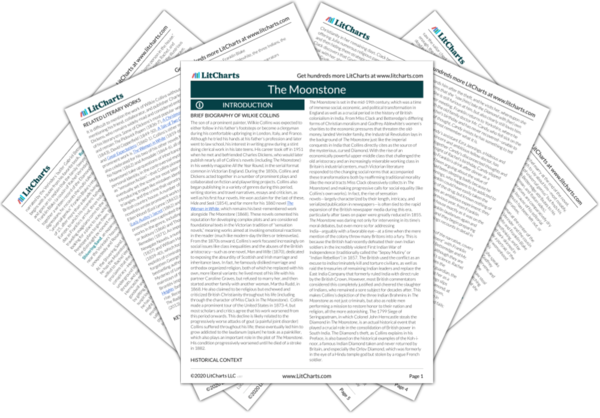Welcome to the LitCharts study guide on Wilkie Collins's The Moonstone. Created by the original team behind SparkNotes, LitCharts are the world's best literature guides.
The Moonstone: Introduction
The Moonstone: Plot Summary
The Moonstone: Detailed Summary & Analysis
The Moonstone: Themes
The Moonstone: Quotes
The Moonstone: Characters
The Moonstone: Terms
The Moonstone: Symbols
The Moonstone: Literary Devices
The Moonstone: Theme Wheel
Brief Biography of Wilkie Collins

Historical Context of The Moonstone
Other Books Related to The Moonstone
Key Facts about The Moonstone
- Full Title: The Moonstone
- When Written: 1868
- Where Written: London
- When Published: Originally serialized Jan 4-Aug 4, 1868; first complete edition 1871
- Literary Period: Victorian Novel
- Genre: Sensation Fiction, Detective Fiction, Victorian Novel
- Setting: Yorkshire, London, India
- Climax: The protagonists discover the corpse of the disguised Godfrey Ablewhite and learn that he stole the Diamond from Franklin Blake
- Antagonist: Godfrey Ablewhite, the three Indians, the cursed Diamond
- Point of View: First person, multiple narrators
Extra Credit for The Moonstone
Adaptations. Owing to its fame, The Moonstone has seen numerous adaptations to formats ranging from the stage (first by the author in 1877) to films (most prominently the celebrated 1934 version), numerous radio plays (in the 1940s and 1950s), and various television series (including in 1959, 1996, 2011, and 2016 by the BBC alone). In fact, there is now even a novel about Collins writing The Moonstone: Drood by Dan Simmons (2009).
Opium and the Author. Opium is not only an important plot point in The Moonstone; Wilkie Collins was also deep into opium addiction while writing the book, so much so that he reported after publishing it, “I was not only pleased and astonished at the finale, but did not recognise it as my own.”
Forgotten First Novel. Wilkie Collins wrote his first novel at the age of 20, when he found himself utterly bored working for a London tea merchant. The book, Iolani: Or, Tahiti as It Was, met universal rejection from publishers and did not resurface until more than 150 years later, when Princeton University Press published it in 1999. Unfortunately, Collins never went to Tahiti in his life, and the book’s exaggerated, stereotyped depiction of a hedonistic, murderous nonwestern civilization lacking “mental virtues” lacks all the grace a modern reader might expect from a writer lauded in his time for his social awareness and progressivism.







